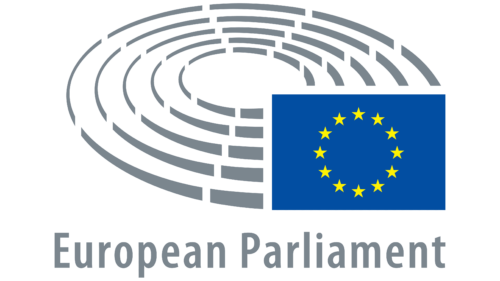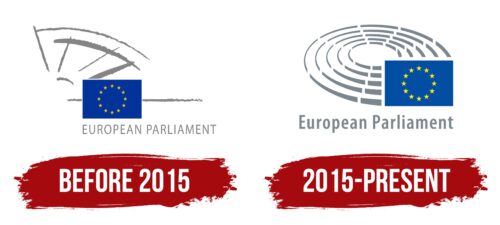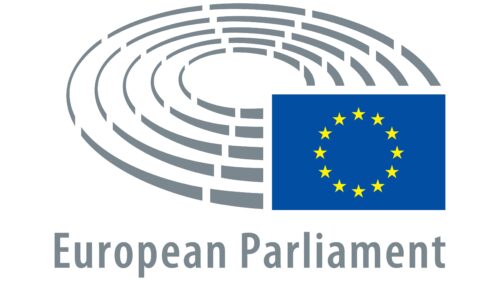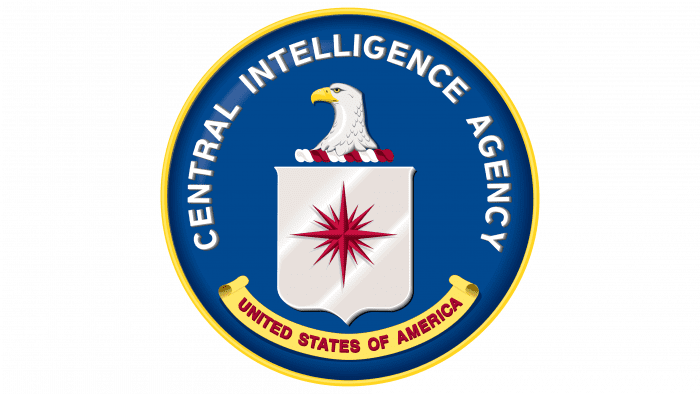The logo of the European Parliament reflects the democratic spirit of the organization. When updating the emblem, all elements were saved. The rebranding made the visual sign more balanced and harmonious.
European Parliament: Brand overview
| Founded: | 10 September 1952 |
| Headquarters: | Strasbourg, France |
| Website: | europarl.europa.eu |
The European Parliament is the legislative body of the EU. It is elected by voting and has, since 2020, consisted of 705 members. Deputies are included in the composition proportionally, according to the percentage of votes received in the elections. They represent 7 political groups—united into 26 commissions. General meetings are held in France, the office in Luxembourg, and small committee meetings in Belgium.
The EP began with a common coal and steel market of 6 European countries. Their first meeting was held in 1952. After five years, the economic and nuclear communities appeared. All three organizations met together and consisted of 142 representatives. They began to call themselves the European Parliament. With the formation of the EU and the integration of countries, the powers of the Parliament expanded. In 1992, the Treaty of Maastricht made the European Parliament the leading legislative body of the union on par with the European Council.
Meaning and History
The European Parliament has its own logo, which is used for official purposes. Its elements symbolize democracy and openness—the main qualities for which the European Union legislature fights. The emblem, created in 2015, contains the institution’s name and the EU flag in the form of a blue rectangle with twelve yellow five-pointed stars and five stylized gray concentric rings representing the meeting room. Until 2015, the design was different, but the layout of the main components looked the same.
What is the European Parliament?
The governing body of the European Union, headquartered in Strasbourg, has the power to legislate, form most of the budget lines and oversee the work of the European Commission.
Until 2015
Until 2015, the emphasis of the emblem was on the Union flag. This is a blue canvas with golden stars in a round dance: a symbol of the sky and the unification of all European countries. The number of stars was controversial. The number 12 chosen as a result is symbolic:
- Corresponds to the clock on the dial. The people are together all the time.
- This alludes to the 12 zodiac constellations. Europe brings together people of different views, characters, and religions. And they are all equal and valuable.
- The designer of the flag was a Catholic. According to his idea, the circle corresponded to the Woman’s crown from the Revelation of John. It is a symbol of the very precious tribes of Israel for God. Each community country is like a star in a democratic, open, and friendly union.
- The crown of immortality is a guarantee of the association’s long existence.
Under the flag was the inscription of the European Parliament in a simple, even font, in capital letters. She conveyed the working atmosphere, the importance of the body, directness, and openness in decision-making.
The conference hall on the logo was depicted quite schematically, in the form of a small sector behind the flag. He hinted that decisions in Parliament are made jointly in the general assembly.
2015 – today
In May 2014, regular elections were held in the European Parliament. The peculiarity of the cadence is that since 2014, the deputies have been electing the head of the EU executive power (the President of the European Commission). It was decided to reflect the renewal and progressive spirit of the new team through a change in the logo.
The new visual sign has become more balanced. The conference room layout was shown in full, with an oval with sectors on the emblem. The image shows a slight forward tilt of the disc. Due to the different heights of the sectors, the room’s scale is demonstrated. The figure indicates a large number of countries in the Parliament, which shows consideration of the interests of all parties.
Also, the oval’s height and slope reflect the meeting room’s features. The chair and secretariat sector are slightly elevated compared to the other seats.
The size of the flag on the new emblem has been increased. It covers the largest sector of the hall and comes to the fore as the main symbol of the Parliament. The number of stars has not changed. But now their number is more explained by political reasons. At the time of adopting the flag, there were 15 EU members, but the recognition of one of the states was controversial; 14 stars rejected two states from the union, 13 – the number of trouble. And 12 came up to all participants as a symbol of perfection. This approach to choice demonstrates the democratic nature of the organization. The logo is also a reminder of the values of Parliament. Today, the European Parliament is the standard of democracy.
The double use of the circle in the hall’s design and on the flag emphasizes community, teamwork, and the close relationship of the participating countries.
The inscription of the European Parliament was lengthened and made more weighty. Now, it occupies the space from one edge of the image to the other. This completes the logo.
Font and Colors
The main colors of the emblem are grey, blue, and gold.
- Gray color – a symbol of the business environment and lawmaking.
- Blue – a sign of constancy, honesty, good fame. Reflects the common sky over the European states.
- Gold demonstrates the value of each European country and the importance of legislative acts issued by the Parliament. It is the antiquity of Europe and the standard, the stronghold of democracy.
The inscription font on the modern logo is fully consistent with Myriad Condensed Semibold. Its rounded letters convey the spirit of seeking compromises and considering each participating country’s opinion.








